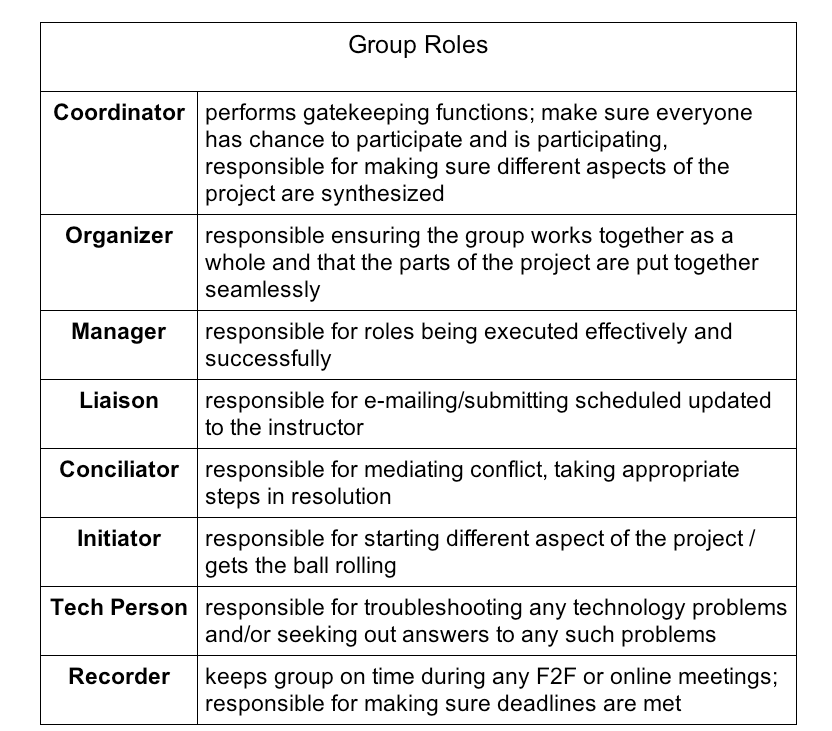Description
Working in groups can be challenging if groups don’t take the time to outline each member’s strengths and potential contributions and also the guidelines for how the group will act and react to situations as the project develops. This is especially true for large-size classes.
Link to example artifact(s)
UCF professor Susan Jardaneh clearly outlined group roles for her students in an online group work project. Designated group roles helps group members know what’s expected of them and what their responsibilities are. Below is a sampling of potential group roles from Professor Jardaneh.

Group Discussion Activity I
- Instructor: UCF’s Dr. Donna Frazee
- TSL4080: Theory and Practice of Teaching ESOL Students in Schools
- Have an introductory discussion interactive early in the term (students introduce themselves, interests, goals or other before others)
- Pre-organize – the more established and structured before opening the module, the smoother the group activity will progress. Most students prefer a structured introduction, with the opportunity to change and be creative.
- Pre-assign members into groups
- Pre-assign roles for each member within group
- Pre-assign assignment responsibility for each member
- Establish group discussion links (Set release criteria)
- Establish/create work file for each group (Google Docs, Wiki or other) – this deletes confusion, need to combine work, and other distracters (such as program versions, accessibility, and others)
- Establish guidelines/dates for when comments, information, rough draft or other is due.
- Within the module’s Table of Contents, add:
- Group chart
- Discussion links
- Netiquette
- Product rubric
- Within instructions, allow students to change and make decisions (member responsibility, topic, or other) – provided they have group consensus and are required to inform instructor, too. Usually, due to the tight time restraints in the online environment (member are on at different times/days), they usually stay with the instructor’s pre-determined structure. If a group wants to make changes, I do check to make sure they stay to the time frame allowed (the instructor may have to set ‘decision’ dates to keep members moving forward).
- Provide multiple ways for teams to interact – discussion tool, chat tool, Adobe Connect virtual room, freeconferencing, and others.
- My projects usually extend over 2 weeks:
- Week one: rough draft
- Week two: finished product
Link to scholarly reference(s)
Holtham, C. W., Melville, R. R., & Sodhi, M. S. (2006). Designing student groupwork in management education: Widening the palette of options. Journal of Management Education. 30(809). https://doi.org/10.1177/1052562906287967
Johnson, D. W., & Johnson, R. T. (1994). Learning together and alone: Cooperative, competitive, and individualistic learning (4th ed.). Boston: Allyn & Bacon.
Citation
Chen, B., & deNoyelles, A. (2015). Establish a group discussion strategy. In B. Chen & K. Thompson (Eds.), Teaching Online Pedagogical Repository. Orlando, FL: University of Central Florida Center for Distributed Learning. https://topr.online.ucf.edu/group-discussion-strategy/.